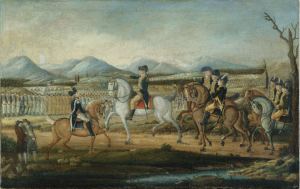Washington and Hamilton accompanied the troops to western Pennsylvania. Hamilton believed that his presence would “have good effect” as the “proposer of a measure, which involves danger to his fellow citizens.”1 With the strength and numbers of the militia, Washington and Hamilton knew that they could make the proper arrests to effectively quiet the insurrection. The long march to western Pennsylvania took Washington through cities such as Harrisburg, Carlisle, Cumberland, and Bedford where he reviewed and organized troops. In early October, word spread quickly regarding the presence of Washington and Hamilton. The newspapers reported their arrival in various cities throughout Pennsylvania along with information regarding troop strength and unit structure.2 3
The tide turned quickly in the federal government’s favor and by 16 October, in regards to the “insurgent counties, Washington wrote, “they are much alarmed at the serious appearance of things.”4 Four days later, Washington left the militia under the command of Governor Henry Lee and headed toward Philadelphia in order to return in time for the next session of Congress. On 15 November, Hamilton wrote to Washington and enclosed a list of twenty insurgents that had been taken into custody and were being held in the town of Washington Pennsylvania. He also stated his intent to depart by the 19th of November and believed that by that time “every thing will have taken its shape.”5
The mass rebellion against the excise on distilled spirits dispersed. In Washington’s sixth annual address to Congress on 19 November, 1794, Washington declared, “Legal process was, therefore, delivered to the marshal, against the rioters and delinquent distillers.”6 By mid-July of the following year, a majority of the rioters involved in the insurrection were granted a full pardon by President Washington.
The goals of Washington and Hamilton were ultimately met. Washington saw the execution of a fully constitutional statute while Hamilton secured his desired source of revenue for the repayment of national debts. Most importantly, the defeat of the rebellion and the enforcement of the law validated the roles of the executive and legislative branch as defined by the United States Constitution.
- David R. Hoth and Carol S. Ebel, ed., The Papers of George Washington Presidential Series. Vol. 16 (Charlottesville and London: University of Virginia Press, 2011), 691. ↩
- “United States, Carlisle, 8 October,” Gazette of the United States, October 18, 1794, 2, accessed December 11, 2103, http://docs.newsbank.com/s/HistArchive/ahnpdoc/EANX/10946AE3177BF680/0D7AB4CAB745C82A. America’s Historical Newspapers (SQN 10946AE206B358E8). ↩
- “Summary of Domestic Intelligence by This Day’s Mail,” Gazette of the United States, September 18, 1794, 3, accessed December 11, 2013, http://docs.newsbank.com/s/HistArchive/ahnpdoc/EANX/1094679E3B30D118/0D7AB4CAB745C82A. America’s Historical Newspapers (SQN 1094679C9EA9B370). ↩
- George Washington, The Writings of George Washington from the Original Manuscript Sources 1745-1799, Vol. 34, (Washington: United States Government Printing Office, 1931), 2. ↩
- Harold C. Syrett, ed., The Papers of Alexander Hamilton, Vol. XVII (New York and London: Columbia University Press, 1967), 373. ↩
- George Washington, The Writings of George Washington from the Original Manuscript Sources 1745-1799, Vol. 34, (Washington: United States Government Printing Office, 1931), 29. ↩
